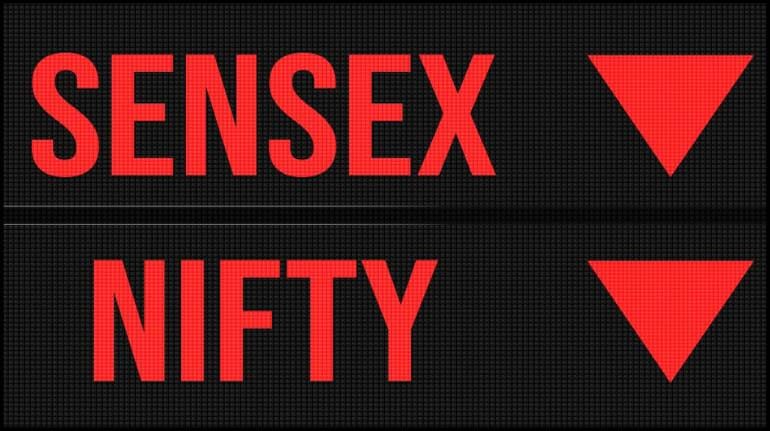



Indian equity markets opened lower on January 25, in-line with global cues, and then extended their decline over the day with Sensex tanking 800 points.
At 11:30 am, the Sensex was down 846 points or 1.39 percent at 60,132. Nifty declined 254.80 points or 1.41 percent at 17,863. About 752 shares advanced, 2350 shares declined, while 111 shares were unchanged.
All sectors are trading in the red with financials taking the biggest hit. Nifty PSU Bank tanked 3.7 percent and Nifty Bank fell 2.3 percent. The biggest losers on the Nifty were Adani Ports, SBI, IndusInd Bank, HDFC Bank and Adani Enterprises.
Follow our live blog for all the market action
Uncertainty around Budget 2023, continuous selling by foreign investors, global growth fears are some of the factors behind this selloff. Let's take a look in details:
Budget 2023
In the short-term, the Union Budget will be a big event for which traders position themselves, building in expectations from the finance minister’s announcements.
"Some simplification of capital gains tax (CGT) is warranted, given the complexity of the current system. However, if the effective rate of equities CGT goes up, it would have a sharply negative effect on the market," Seshadri Sen of Alchemy Capital Management said.
Foreign brokerage Morgan Stanley expects the fiscal deficit to be 5.9 percent of the GDP in FY24 against 6.4 percent for FY23.
“There is a need to consolidate the fiscal deficit. The starting point of 6.4 percent is already so elevated that markets will not like it if there is any further slippage. Our estimation of 5.9 percent is a gradual consolidation path. 6 percent or anything above 6 will be a tad negative for markets,” Upasana Chachra, Chief India Economist, Morgan Stanley said.
FII Selling
Just like 2022, foreign institutional investors (FIIs) have been selling Indian equities in the new year as well. Till date, FIIs have already sold around $1.6 billion in stocks.
Financials and IT have faced the maximum brunt of this selling, followed by consumer services, oil & gas, telecommunication and autos. "The simple logic behind sustained FII selling is that India is the only large market where FIIs are still sitting on good profits after the disastrous 2022 performance in most global markets," believes Dr. V K Vijayakumar, Chief Investment Strategist at Geojit Financial Services.
Growth to slow in 2023-24: Moody’s
India's gross domestic product (GDP) growth is seen declining to 5.6 percent in 2023-24, although it will still be one of the best performing large economies in the G-20, said Christian de Guzman - senior vice-president at Moody's Investors Service and primary analyst for India.
"This real growth forecast is still amongst the healthiest in the entire G-20. And we think potential growth can be sustained around 6 percent," de Guzman told in an interview.
A GDP growth rate of 5.6 percent would be well below the government's first advance estimate of 7 percent for this year and the Reserve Bank of India's (RBI) forecast of 6.5 percent for next year.
F&O expiry day
Markets usually witness a lot of volatility on expiry day. Santosh Meena, Head of Research, Swastika Investmart Ltd, believes the market is following last year's pattern. In 2022, the Nifty saw a doji candle (which indicates a range-bound move) in the second and third weeks of January, followed by a sharp fall in the final week of January.
"Technically, Nifty is near the critical support level of 17,800, and if it falls below this, then 17,625 and 17,425 are the next support levels. On the upside, 18,200 is a critical hurdle; above this, we can expect a rally toward 18,500 and 18,650 levels," he said.
Jittery global cues; all eyes on Fed
The S&P 500 ended nominally lower on January 24 at the close of a rocky session. The Dow Jones Industrial Average rose 104 points to 33,733, the S&P 500 lost 2.86 points to 4,016.95 and the Nasdaq Composite dropped 30.14 points to 11,334. Tracking Wall Street overnight, Asian markets also opened mixed on January 25.
All eyes are now on Federal Open Market Committee's (FOMC) interest rate decision that will be announced on February 1. The interest-rate move is currently expected to be smaller than past hikes at 0.25 percentage-points. "Worse-than- expected hawkish Fed can break the lower end of the market range," said Vijayakumar.
Discover the latest Business News, Sensex, and Nifty updates. Obtain Personal Finance insights, tax queries, and expert opinions on Moneycontrol or download the Moneycontrol App to stay updated!
Find the best of Al News in one place, specially curated for you every weekend.
Stay on top of the latest tech trends and biggest startup news.